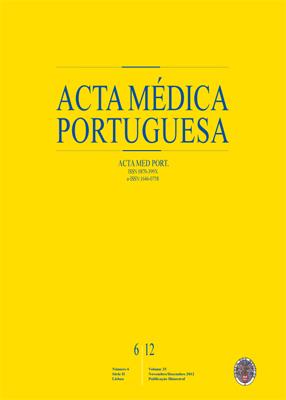Neoadjuvant Radiotherapy and Hormonotherapy in Locally Advanced Breast Cancer: State of the Art
DOI:
https://doi.org/10.20344/amp.1359Abstract
Introduction: Breast cancer is a health problem of great magnitude. In recent years we have seen an increasing incidence anddecreasing mortality from this disease due to implementation of campaigns for early diagnosis and the effectiveness of existing treatments.For more than a century that we know the evidence that growth and development of some tumours depends in part on hormonalstimuli, and the purpose of hormone therapy to prevent the hormonal stimulation of cell proliferation, decreasing the plasma levels ofdifferent hormones. Radiotherapy which uses a controlled ionizing radiation for therapeutic purposes, it is one of the fundamental modalitiesin the treatment of cancer. According to the international guidelines these modalities of treatment, radiotherapy and hormonetherapy, can be used in the treatment of breast cancer both within the neoadjuvant, adjuvant or palliative treatment.Objectives: Obtain data to support or not the use of concomitant radiotherapy and neoadjuvant hormone therapy instead to neoadjuvantechemotherapy in post menopausal patients diagnosed with locally advanced breast cancer and positive hormone receptors.Methods: Bibliographic search in MEDLINE databases, and evidence based review databases, using the MeSH terms: Radiotherapy,Hormonotherapy, Tamoxifen, Neoadjuvant, Endocrine Therapy, Breast of articles published at any time and in English, Portuguese,French and Spanish. It was also researched the Index of Portuguese Medical Journal and scientific societies dedicated to Oncology.Results: We analyzed 32 studies (in vitro experiments, animal studies and clinical studies). There was the existence of antagonisticinteraction between Radiotherapy and Tamoxifen in the in vitro studies, which has not been confirmed in the animal studies and clinicaltrial. Clinical studies suggest that a combination of radiotherapy and Tamoxifen increases the local control in the in situ carcinoma likein the invasive breast cancer. The available clinical studies do not demonstrate that the simultaneous application of Radiotherapy andtamoxifen is disadvantageous, as suggested in the in vitro studies. However, the tolerance of lung tissue to radiation may be slightlyreduced if tamoxifen is given concurrently with radiotherapy, such as swelling of the breast and its duration can be increased. The cosmeticresults were not harmed in the combined treatment, except for one study where there was an increased of hyperpigmentation.Finally, the combined treatment was an increase in cardiovascular events.Conclusions: In the literature there are few studies on these issues, most of which are adjuvant intention in women with breast cancer taatan early stage, and the results are inconclusive. There is great uncertainty in the combination of the two modalities. There isn’t arandomized study where differences in local control when hormonotherapy is initiated before, during or after radiation therapy wereinvestigated.
Downloads
Downloads
Published
How to Cite
Issue
Section
License
All the articles published in the AMP are open access and comply with the requirements of funding agencies or academic institutions. The AMP is governed by the terms of the Creative Commons ‘Attribution – Non-Commercial Use - (CC-BY-NC)’ license, regarding the use by third parties.
It is the author’s responsibility to obtain approval for the reproduction of figures, tables, etc. from other publications.
Upon acceptance of an article for publication, the authors will be asked to complete the ICMJE “Copyright Liability and Copyright Sharing Statement “(http://www.actamedicaportuguesa.com/info/AMP-NormasPublicacao.pdf) and the “Declaration of Potential Conflicts of Interest” (http:// www.icmje.org/conflicts-of-interest). An e-mail will be sent to the corresponding author to acknowledge receipt of the manuscript.
After publication, the authors are authorised to make their articles available in repositories of their institutions of origin, as long as they always mention where they were published and according to the Creative Commons license.









